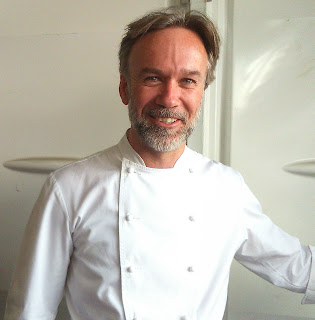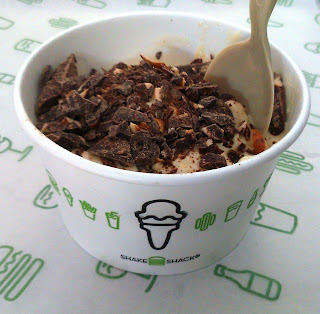...
Foie Royale ... is not Foie Gras ....................................................................................................What The Foie?
20:20
Those who have followed Ambassadors of Food for some time will know we only ever write about great experiences, places, people and products we love. It, therefore, gives us tremendous pleasure to introduce you to Foie Royale.
We first encountered Foie Royale at the recent Chefs Forum lunch in West London, where Mike Logut, Managing Director of pan-European meat & poultry supplier Sapphire Foods, gave us a taste of this wonderful product.
Foie Royale is a sensational, ethical and cruelty-free alternative to foie gras, the product of six years of development and research.
Over the years Ambassadors of Food has seen various trends in the hospitality industry, one of the most noticeable being consumers becoming more ethically minded than ever. One needn’t be Sherlock Holmes to spot a massive increase in vegetarian offerings across most of the industry. Many restaurants have entirely removed ingredients now perceived as cruel, from their menus, perhaps the most obvious being foie gras.
Foie gras was once a staple luxury on many a Michelin-starred menu, whereas these days it is far less prevalent and for good reason. For those unfamiliar with the traditional process of making foie gras here’s a brief crash course (Warning the following information may be distressing but no animals were harmed in the writing of this piece):
 |
| Base relief from the necropolis of Saqqara, in the tomb of an important royal official named Mereuka, depicting workers grasping geese around the necks to push food down their throats. |
Fattening bird livers goes back to at least 2,500 BC when the ancient Egyptians learned birds could be fattened through the grim practice of forced overfeeding.
Foie gras literally means ‘fatty liver’ in French. Considered a luxury product, geese and ducks are force-fed via a tube 2 or 3 times a day, the poor birds are then slaughtered after around 100 days.
The force-feeding process, called ‘gavage’, is highly controversial because it is so cruel. To compound the cruelty, typically birds are housed in cramped conditions and lead miserable lives, with clipped beaks and wings.
Several countries have banned gavage and understandably many restaurants have removed foie gras from the menu because so many diners avoid it.
Some foie gras producers claim their product is more ethical because rather than force-feeding them, birds are merely encouraged to gorge themselves. ‘Ethical’ foie gras is also the preferred terminology of producers who use rubber tubes rather than metal feeding pipes when force-feeding; pushing the definition of ‘ethical’ to the extreme.
Whether gorging or gavage, ultimately the birds end up with fatty livers around 10 times larger than nature intended, which must be terribly painful for the poor creatures.
With most meat, it’s the fat which delivers the flavour. The best steaks have plenty of marbling from fat incorporated into the flesh and roast duck would be rather flaccid without a burst of flavour from the thick layer of fat under the skin.
Previously, the only known method to achieve the taste and consistency of an excellent foie gras was to fatten a bird’s liver whilst it is still alive.
Now, Foie Royale is a sensational product, which has succeeded in adding the fat to the liver after the goose or duck has been slaughtered, yet it tastes and looks as good as the best foie gras, with the same consistency, flavour and qualities one would expect from foie gras served at the very best restaurants, melt in the mouth smoothness with the structure of a silky pâté.
Foie Royale was created by Joeri Groot, working with Robert Meyer, a farmer who knows his poultry, supplying supermarkets in Europe. Having seen how geese were force-fed in France, Groot determined to find a humane alternative.
To put things in perspective, Meyer is no ordinary farmer. He cares deeply about the welfare of his animals. So much so, he helped develop some of the most humane methods imaginable to avoid causing geese stress.
Mike from Sapphire Foods, explained that whilst on Robert Meyer’s farm shooting some drone footage, one goose appeared to be not moving and feared dead. Upon seeing this Meyer became tearful, only for sadness to turn to joy as the goose was just fine and had simply dozed off.
This level of care shows why Meyer is a special farmer.
This level of care shows why Meyer is a special farmer.
The birds are entirely free-range, living in large barns with a minimum of 25m² each, naturally heading outside when the sun rises, to forage in fields, returning to the barn to sleep when the sun sets. When mature and are ready for slaughter the ducks and geese are transported with specially installed low lighting to avoid disturbing the birds.
The unusually high quality of attention and care delivers stunning results, a product equal to the very best foie gras on the market, bar one crucial difference - Foie Royale is NOT foie gras.
Q. What do you get when you cross an ethical farmer with a mad scientist?
A. Evolution, progress and a truly wonderful product.
Around six years ago Groot started working with ordinary, non-fatty livers but was unsuccessful in achieving something to properly rival the best foie gras. Displaying the sort of perseverance required of great inventors, Groot began working with the German Institute for Food Technology (DIL) in Quakenbrück, and meat technologist Nino Terjung, known as the “mad scientist”. Together, they developed a process using ‘pascalization’ where goose fat, removed from beneath birds’ skin is fused with the liver under extreme pressure, creating Foie Royale.
Foie Royale is silky smooth and we think it tastes indistinguishable from the very best foie gras, except it’s made from healthy livers and fats without force-feeding.
Several Michelin starred chefs have already taken to Foie Royale. It can be eaten cold, blended, blitzed or cooked just as you would a foie gras. One of our favourite methods is served on brioche with shallots.
In the words of Jan de Wit from the One Michelin starred "Le Restaurant" in Amsterdam, “put a drop of old balsamic vinegar with apple and I would dare to dare.”
In the words of Jan de Wit from the One Michelin starred "Le Restaurant" in Amsterdam, “put a drop of old balsamic vinegar with apple and I would dare to dare.”
We’re clearly not the only people to have been utterly delighted and wowed by this wonderful product, because Foie Royale’s Block of Goose and Block of Duck are two of the five products chosen as finalists in the poultry category for the 2019 Chefs’ Choice Awards.
To try Foie Royale for yourself visit
or for those in the trade














































































































